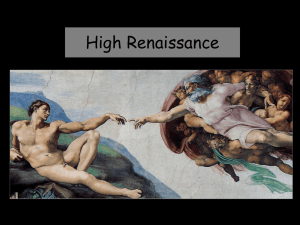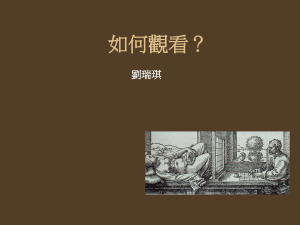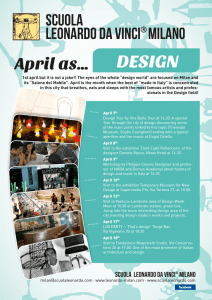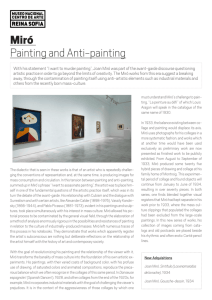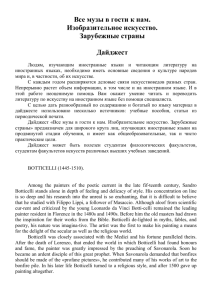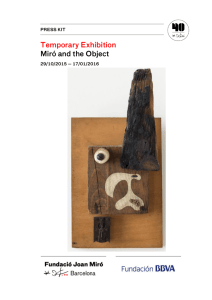Michelangelo - Moore Public Schools
advertisement
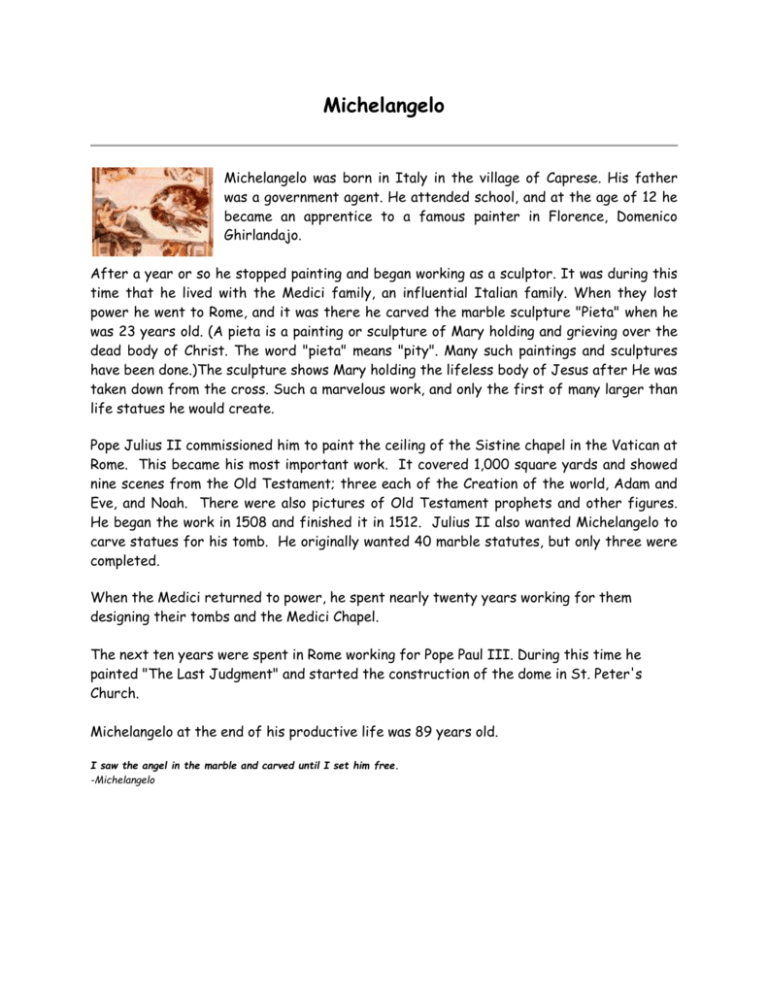
Michelangelo Michelangelo was born in Italy in the village of Caprese. His father was a government agent. He attended school, and at the age of 12 he became an apprentice to a famous painter in Florence, Domenico Ghirlandajo. After a year or so he stopped painting and began working as a sculptor. It was during this time that he lived with the Medici family, an influential Italian family. When they lost power he went to Rome, and it was there he carved the marble sculpture "Pieta" when he was 23 years old. (A pieta is a painting or sculpture of Mary holding and grieving over the dead body of Christ. The word "pieta" means "pity". Many such paintings and sculptures have been done.)The sculpture shows Mary holding the lifeless body of Jesus after He was taken down from the cross. Such a marvelous work, and only the first of many larger than life statues he would create. Pope Julius II commissioned him to paint the ceiling of the Sistine chapel in the Vatican at Rome. This became his most important work. It covered 1,000 square yards and showed nine scenes from the Old Testament; three each of the Creation of the world, Adam and Eve, and Noah. There were also pictures of Old Testament prophets and other figures. He began the work in 1508 and finished it in 1512. Julius II also wanted Michelangelo to carve statues for his tomb. He originally wanted 40 marble statutes, but only three were completed. When the Medici returned to power, he spent nearly twenty years working for them designing their tombs and the Medici Chapel. The next ten years were spent in Rome working for Pope Paul III. During this time he painted "The Last Judgment" and started the construction of the dome in St. Peter's Church. Michelangelo at the end of his productive life was 89 years old. I saw the angel in the marble and carved until I set him free. -Michelangelo The Sistene Chapel Ceiling http://www.michelangelo.com/buon/bio-index2.html Miro, Joan The Spanish painter, Joan Miró, who was born in Barcelona in 1893 and died in Palma de Mallorca in 1983, left behind an important legacy which is included amongst the most original of the 20th century. His work, in general, would be marked with a clear surrealist tendency, where the realm of the memory and imaginative fantasy were to take priority. He studied at La Lonja School of Fine Arts in Barcelona, and in 1918 set up his first individual exhibition in the Dalmau Galleries, in the same city. His works before 1920 (the date of his first trip to Paris) reflect the influence of different trends, like the pure and brilliant colors used in Fauvism, shapes taken from cubism, influences from folkloric Catalan art and Roman frescos from the churches. His trip to Paris introduced him to and developed his trend of surrealist painting. In 1921, he showed his first individual exhibition in Paris, at La Licorne Gallery. In 1928, he exhibited with a group of surrealists in the Pierre Gallery, also in Paris, although Miró was always to maintain his independent qualities with respect to groups and ideologies. From 1929-1930, Miró began to take interest in the object as such, in the form of collages. This was a practice which was to lead to his making of surrealist sculptures. His tormented monsters appeared during this decade, which gave way to the consolidation of his plastic vocabulary. He also experimented with many other artistic forms, such as engraving, lithography, water colors, pastels, and painting over copper. What is particularly highlighted from this period, are the two ceramic murals which he made for the UNESCO building in Paris (The Wall of the Moon and the Wall of the Sun, 1957-59). It was at the end of the 60´s when his final period was marked and which lasted until his death. During this time, he concentrated more and more on monumental and public works. He was characterized by the body language and freshness with which he carried out his canvasses, as well as the special attention he paid to material and the stamp he received from informalism. He concentrated his interest on the symbol, not giving too much importance to the theme, but to the way the symbol emerged as the piece of work. In 1976 the Joan Miró Foundation Centre of Contemporary Art Study was officially opened in the city of Barcelona and in 1979, four years before his death, he was named Doctor Honoris Causa by the University of Barcelona. " I try to apply colors like words that shape poems, like notes that shape music" - Joan Miro Joan Miró. Harlequin's Carnival. 1924-25. Oil on canvas. http://www.abcgallery.com/M/miro/miro.html Joan Miro’s Painting of Toledo Da Vinci, Leonardo Leonardo Da Vinci was born in a small village called Vinci in the country of Italy. He was raised by his grandparents and even as a boy showed signs of genius. He could work hard mathematics problems and was a very good artist. His father Piero recognized that he had artistic talent and sent him to Florence to study with the artist Verrocchio. In addition to art he also learned sculpture and engineering. Soon he was a better artist than his teacher. At age 20 he was accepted into the painters' guild in Florence. About ten years later he was hired by Sforza, who later became Duke of Milan. It was during this time he painted The Last Supper. Artists through the centuries had used egg tempera as the base for their paint, but Leonardo wanted to try something new, so he applied plaster to the wall and painted on the dried plaster. Unfortunately the plaster began to flake off after just a short time and the painting has required a lot of repair through the years. When the French army captured Milan, the duke had to flee, and Leonardo went back to Florence. It was here he painted the portrait of the wife of a merchant named Giocondo. It is called La Giocando, or Mona Lisa. Legend has it he hired musicians to play while he painted the portrait so his subject would stay in a good mood. Numerous words have been written about the painting and it remains one of the most recognizable paintings in the world. He was a musician who invented musical instruments. He would compose, then play and sing his own songs. Probably of greater importance than his paintings are the contributions Leonardo made in the areas of engineering and architecture. He along with Michelangelo, Raphael, and Bramante designed St. Peter's Church in Rome as well as other buildings in the Vatican. Leonardo kept books of sketches he made. He studied human anatomy and drew sketches of the body. He had ideas for inventions that would not be developed for hundreds of years. He had an idea for a flying machine, a propeller, and for weapons of war. He designed and built bridges, canals and locks to carry water and move ships. He could write with both his right and left hands. We say such a person is ambidextrous. He wrote his notes backwards with his left hand and read them in a mirror. Today you could find nearly 7,000 pages of his notes which still exist. Leonardo Da Vinci was truly a man ahead of his time. “Art is never finished, only abandoned.” – Da Vinci The Last Supper 1498 (180 Kb); Fresco, 460 x 880 cm (15 x 29 ft); Convent of Santa Maria delle Grazie (Refectory), Milan http://www.ibiblio.org/wm/paint/auth/vinci/ Portrait of Mona Lisa (1479-1528), also known as La Gioconda, the wife of Francesco del Giocondo; 1503-06 (150 Kb); Oil on wood, 77 x 53 cm (30 x 20 7/8 in); Musee du Louvre, Paris http://www.ibiblio.org/wm/paint/auth/vinci/joconde Homer, Winslow Winslow Homer, the son of a Boston hardware merchant, was born in 1836 and spent his childhood fishing instead of studying art. His only early training was an apprenticeship to a lithographer for whom he drew pretty girls to adorn the covers of popular songs. By 1857, however, he was an illustrator for Harper's Weekly drawing happy scenes of country life at first and then, during the Civil War, pictures of the loneliness and the pastimes of soldiers far from home. He painted his first oil during this period, again with almost no instruction; for Homer believed that a man who wished to be an artist must not look at other artists' work. Consequently, he remained resolutely alone, refusing to have anything to do with European art. After the war he returned to New York where he continued as an illustrator and painted a series of genre pictures of children and country life. These met with both enthusiastic public approval and some critical disapproval. Often repeated by later critics, the complaint centered around being disturbed by the simplicity and the force of Homer's statements. Like all artists who work alone, Homer matured slowly, and as he matured, he lost interest in portrayals of the land and children. In 1883, he moved from New York to Maine where he set up a studio close to the wild and rocky coast and began his series of watercolors of the sea and its people, before finally losing interest in people altogether, and confining himself almost entirely to "the lonely sea and the sky." His watercolors are so powerful that it is difficult to believe that Homer was himself "a small, reserved gentleman, quiet and unostentatious." His view of nature was severe and, even in the scenes of tropical waters, brilliant in color, indicative of his belief that man himself is nothing in comparison to the vastness of the ocean. Homer's lofty point of view found fewer admirers than had his earlier, more easily fathomed works but he was not without recognition even before his death, in 1910, and is today ranked as one of the finest of the world's watercolorists. "You will see, in the future I will live by my watercolors." -Homer July 12, 1962 - The War for the Union -The Bayonet Charge http://www.sonofthesouth.net/Winslow_Homer.htm July 5, 1862 - The War for the Union - The Cavalry Charge




